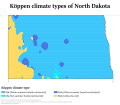Portal:North Dakota
The North Dakota Portal North Dakota ( /dəˈkoʊtə/ ⓘ də-KOH-tə) is a landlocked U.S. state in the Upper Midwest, named after the indigenous Dakota Sioux. It is bordered by the Canadian provinces of Saskatchewan and Manitoba to the north and by the U.S. states of Minnesota to the east, South Dakota to the south, and Montana to the west. North Dakota is part of the Great Plains region, characterized by broad prairies, steppe, temperate savanna, badlands, and farmland. North Dakota is the 19th-largest state by area, but with a population of just under 800,000, it is the fourth-least populous and fourth-most sparsely populated. The state capital is Bismarck while the most populous city is Fargo, which accounts for nearly a fifth of the state's population; both cities are among the fastest-growing in the U.S., although half of all residents live in rural areas. What is now North Dakota was inhabited for thousands of years by various Native American tribes, including the Mandan, Hidatsa, and Arikara along the Missouri River; the Ojibwe and Cree in the northeast; and several Sioux groups (the Nakota, Dakota, and Lakota) across the rest of the state. European explorers and traders first arrived in the early 18th century, mostly in pursuit of lucrative furs. The United States acquired the region in the early 19th century, gradually settling it amid growing resistance by increasingly displaced natives. The Dakota Territory, established in 1861, became central to American pioneers, with the Homestead Act of 1862 precipitating significant population growth and development. The traditional fur trade declined in favor of farming, particularly of wheat. The subsequent Dakota Boom from 1878 to 1886 saw giant farms stretched across the rolling prairies, with the territory becoming a regional economic power. The Northern Pacific and Great Northern railway companies competed for access to lucrative grain centers; farmers banded together in political and socioeconomic alliances that were core to the broader Populist Movement of the Midwest. North and South Dakota were admitted to the Union on November 2, 1889, as the 39th and 40th states. President Benjamin Harrison shuffled the statehood papers before signing them so that no one could tell which became a state first; consequently, the two states are officially numbered in alphabetical order. Statehood marked the gradual winding-down of the pioneer period, with the state fully settled by around 1920. Subsequent decades saw a rise in radical agrarian movements and economic cooperatives, of which one legacy is the Bank of North Dakota, the only state-run bank in the U.S. (Full article...) Selected article -The Battle of Whitestone Hill (known also as Whitestone Hill Massacre by the Dakota) was a battle of the Sioux Wars in 1863 in the Dakota Territory as punishment against the Sioux in the aftermath of the Dakota War of 1862. From September 3-5, 1863, Brigadier General Alfred Sully led U.S. Army troops against a village of Yanktonai, Santee, and Teton (Lakota) Sioux. The reported casualties vary, but U.S. Army troops killed somewhere between 150 and 300 Sioux and captured between 150 and 250 Sioux, including women and children, and they suffered approximately 22 killed and 38 wounded. (Full article...) CategoriesGeneral images -The following are images from various North Dakota-related articles on Wikipedia.
Did you know -
TopicsLargest cities
Recognized content
Featured articlesFeatured listsGood articlesDid you know? articles
Good article nomineesFormer featured articlesFormer good articlesNew articlesThis list was generated from these rules. Questions and feedback are always welcome! The search is being run daily with the most recent ~14 days of results. Note: Some articles may not be relevant to this project.
Rules | Match log | Results page (for watching) | Last updated: 2025-01-27 22:04 (UTC) Note: The list display can now be customized by each user. See List display personalization for details.
Related portalsWikiProjectsAssociated WikimediaThe following Wikimedia Foundation sister projects provide more on this subject:
Sources
|

































